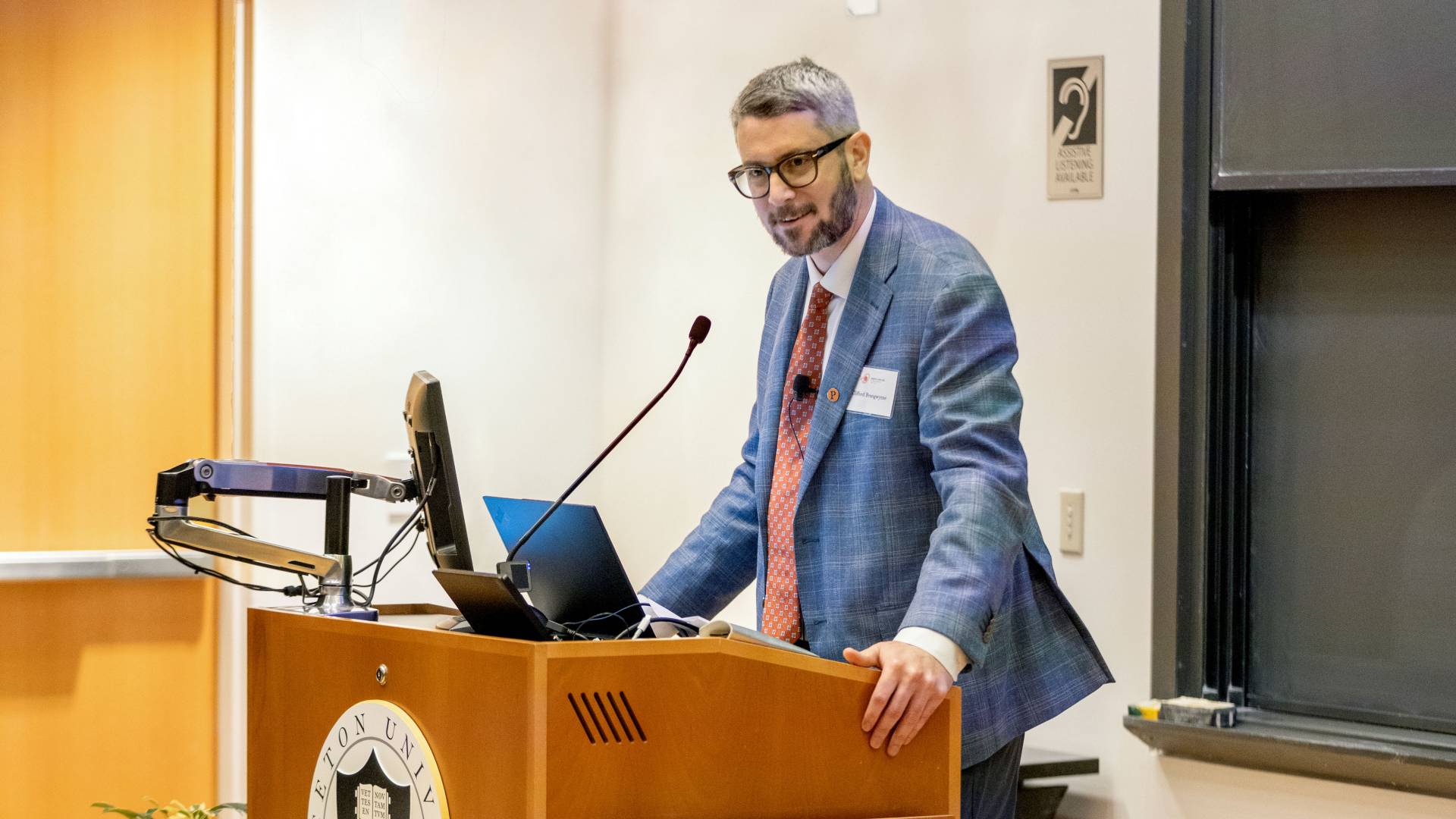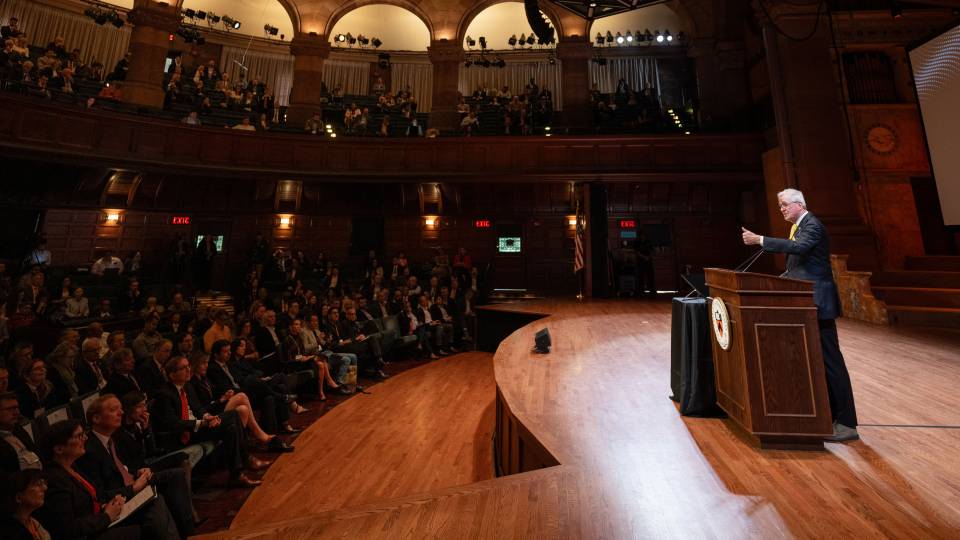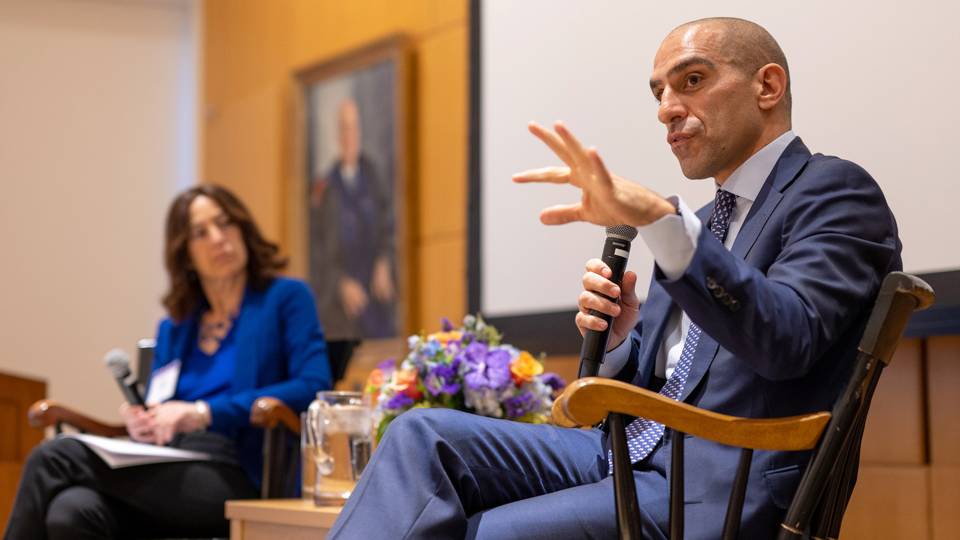Clifford Brangwynne, director of the Omenn-Darling Bioengineering Institute, speaks at the dedication event, noting that “bioengineers at Princeton and around the globe are forging new paths that promise a better future for human health and society.” The institute includes a team of core faculty members and also convenes affiliated faculty in engineering, genomics, neuroscience, molecular biology, physics, chemistry, and ecology and evolutionary biology.
At an event dedicating the Omenn-Darling Bioengineering Institute, Princeton University emphasized its commitment to innovative research in the life sciences and engineering, informed by collaboration with Princeton’s world-class experts in the humanities, ethics and policy.
Members of the Princeton University community gathered in the Friend Center on May 6 for a dedication event for the new institute, which included a guest lecture and panel discussion on the vast potential for bioengineering inquiry to benefit medicine, healthcare and the environment.
A transformative gift in the Venture Forward campaign from alumni Gilbert Omenn ’61 and Martha Darling *70 named the institute, which is promoting new directions in research, education and innovation at the intersection of engineering and the life sciences while serving as the home for new interdisciplinary bioengineering postdoctoral, graduate and undergraduate programs.
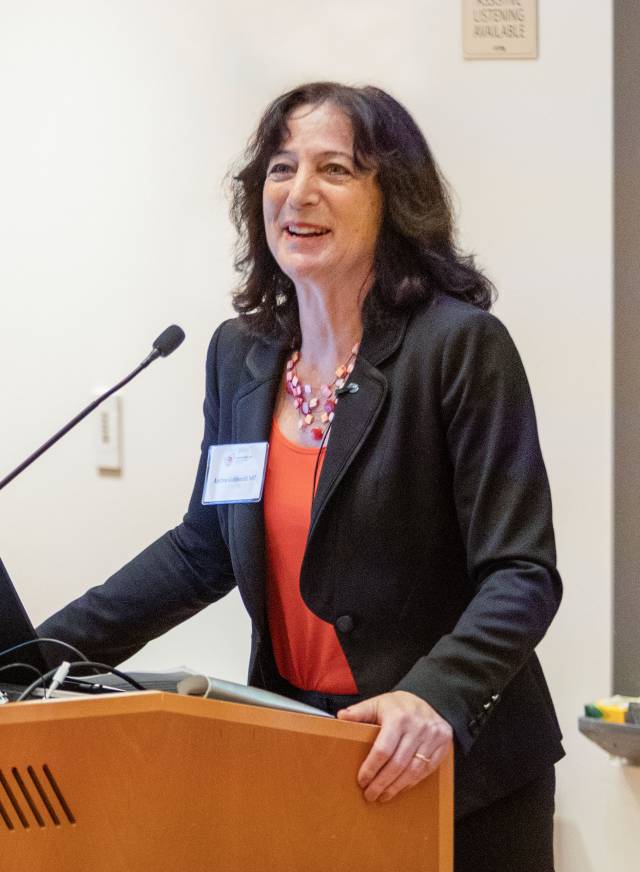
“You are all entrepreneurs,” said School of Engineering and Applied Science Dean Andrea Goldsmith, addressing Omenn-Darling Bioengineering Institute faculty, students and staff. “You have all started something new. … And that gives you the opportunity to really forge something special here that will have impact well beyond what anyone can do on their own.”
“Gil and Martha, I want you to know how meaningful it is for us to be naming this bioengineering institute in your honor,” said President Christopher L. Eisgruber at the event. “We are deeply grateful for your generosity and for your partnership with Princeton in imagining the future of this transformative scientific enterprise.”
A welcome from Andrea Goldsmith, dean of the School of Engineering and Applied Science and Arthur LeGrand Doty Professor of Electrical and Computer Engineering, kicked off the event, followed by remarks from Clifford Brangwynne, director of the Omenn-Darling Bioengineering Institute and June K. Wu ’92 Professor of Chemical and Biological Engineering.
“You are all entrepreneurs,” said Goldsmith, addressing Omenn-Darling Bioengineering Institute faculty, students and staff. “You have all started something new. This is one of the first new institutes at Princeton in quite some time. And that gives you the opportunity to really forge something special here that will have impact well beyond what anyone can do on their own. That’s what I find so exciting about this launch of the institute today.”
The institute includes a team of core faculty members — led by inaugural director Brangwynne — and also convenes affiliated faculty from the School of Engineering and Applied Science, the Lewis-Sigler Institute for Integrative Genomics, the Princeton Neuroscience Institute and the departments of molecular biology, physics, chemistry, and ecology and evolutionary biology.
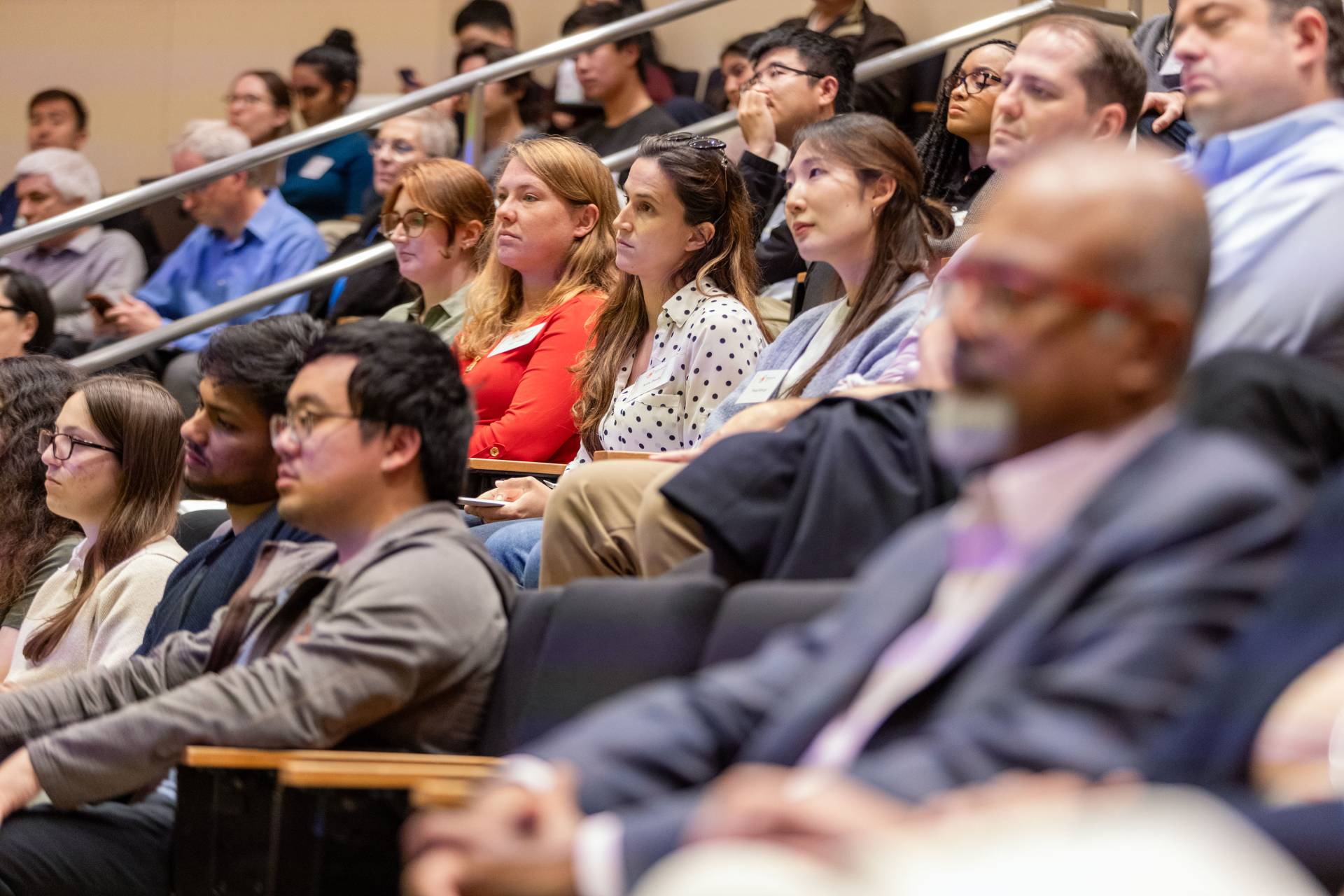
Audience members take in the event, which featured keynote speaker Daniel Fletcher’s address, “Bioengineering for a Better Future,” and a panel of experts who discussed the future of bioengineering, the roles of ethics and policy, and opportunities for entrepreneurship and commercializing emerging technologies, among other topics.
The main areas of focus of the Omenn-Darling Bioengineering Institute are cellular engineering, device engineering and computational bioengineering, as well as the ethical and public policy implications of such new ideas and technologies. An important aspect of the institute’s work is to bolster innovation and entrepreneurship by collaborating with the region’s biotech and pharmaceutical industries.
"The establishment of this institute is truly a game-changer for Princeton’s impact on this rapidly evolving field,” said Brangwynne. “Right now, bioengineers at Princeton and around the globe are forging new paths that promise a better future for human health and society," he said, introducing keynote speaker Daniel Fletcher ’94, professor of bioengineering and biophysics and Purnendu Chatterjee Chair of Engineering Biological Systems at the University of California, Berkeley.
Fletcher’s lecture, titled “Bioengineering for a Better Future,” addressed his lab’s work understanding how biological systems at the cellular level are built, how they break, and what to do to fix them. He also shared the evolution of the mobile microscopy he’s developed to diagnose diseases like tuberculosis and malaria in remote locations outside of the laboratory.
“When the biological sciences meet the physical sciences and new capabilities are generated, it really requires us to think carefully about policy implications for the future,” Fletcher said. “We have a responsibility in academia to make the world a better place. Princeton is poised to enable so much creativity in a responsible way with this institute.”
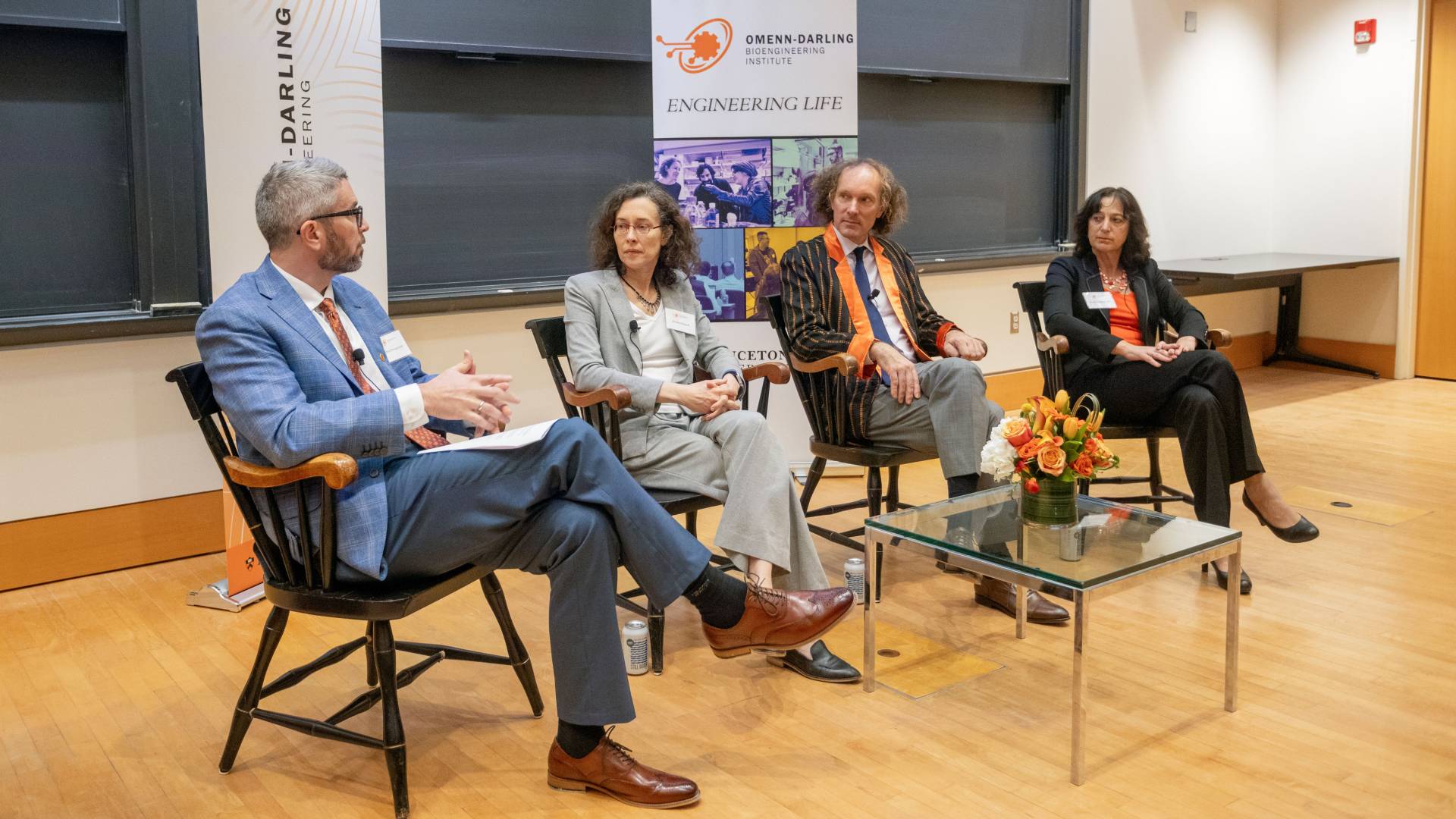
The event's dynamic panel discussion featured (from left) Brangwynne, Johns Hopkins professor Jennifer Elisseeff, keynote speaker Daniel Fletcher ’94, who is a professor at the University of California, Berkeley, and Princeton's Goldsmith.
A dynamic panel discussion followed Fletcher’s lecture, featuring moderator Brangwynne, Goldsmith, Fletcher and Jennifer Elisseeff, professor in the departments of biomedical engineering, orthopedic surgery, chemical and biological engineering, and materials science and engineering at Johns Hopkins University.
The discussion encompassed what the panelists find exciting in the future of bioengineering; the function of data, computing and artificial intelligence; the roles of ethics and policy; and opportunities for entrepreneurship and commercializing emerging technologies, among other topics.
“When I think about the three areas of focus for this institute — engineering, living systems, living cells [as well as] biomedical devices and AI — it’s almost impossible to imagine how much impact and what we will be creating over the next decade or two,” said Goldsmith.
A formal dedication ceremony followed the lecture and panel discussion, with Brangwynne introducing Omenn and Darling. “Gil and Martha understand bioengineering at a core level, and they also understand why Princeton is the perfect place for an institute that will revolutionize the field,” he said. “Princeton’s unsurpassed culture of collaboration has been essential for my research, which uses fundamental principles of physics and materials science to understand and engineer structures within living cells. These cellular systems are among the most complex forms of matter in the universe, and it has been helpful for me to partner with experts in diverse fields. This kind of interdisciplinary collaboration makes Princeton a truly special place for trailblazing science and engineering.”
Omenn, who is the Harold T. Shapiro Distinguished University Professor at the University of Michigan, shared the trajectory of his notable career as a physician, biomedical and public health researcher, and academic leader, as well as his service in several national policy roles. “There’s something very special about a career in science, medicine and engineering,” he said. “The path is not written in advance. You make the plot as you make decisions. It turns out in many cases to be quite remarkable — and I’m pleased to be in a position to do this together with Martha.”
Darling was one of the first female graduate students at what is now Princeton’s School of Public and International Affairs (SPIA), earning a master of public affairs degree in 1970. Her focus was international economics and politics and she worked in senior leadership at Boeing and served in numerous national and state policy roles. “What I’m really here to endorse is interdisciplinary collaboration,” she said, “out of which a lot of huge, important things will come. I know with great confidence that in the years to come we will see what greatness this bioengineering institute has meant for Princeton, New Jersey, the United States and the world.”
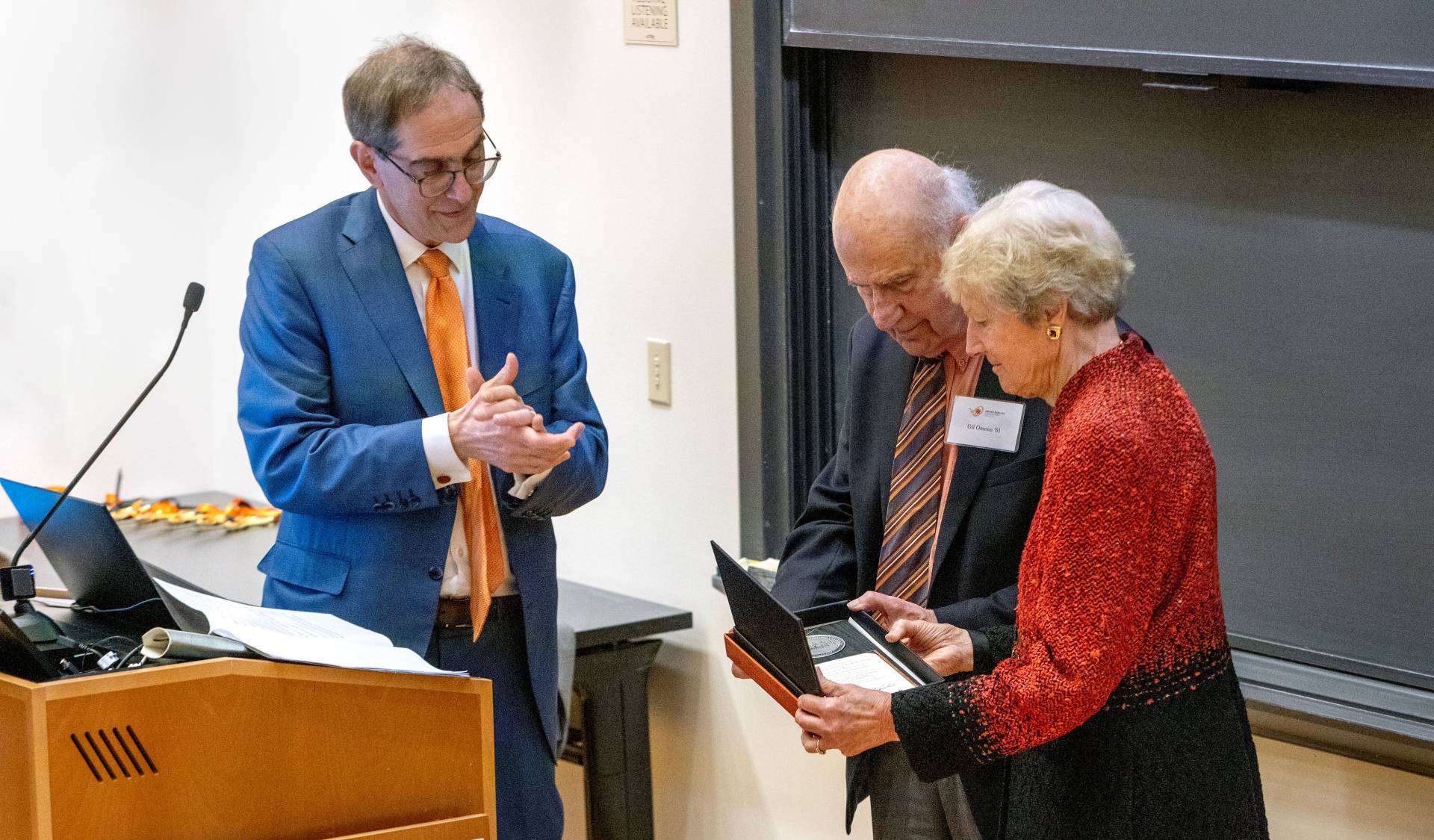
A transformative gift in the Venture Forward campaign from alumni Gilbert Omenn ’61 and Martha Darling *70 named the institute. “We are deeply grateful for your generosity and for your partnership with Princeton in imagining the future of this transformative scientific enterprise,” President Christopher L. Eisgruber said at the event.
“As we celebrate this visionary science — and these scientists — who aren’t afraid to challenge prevailing wisdom or cross disciplinary boundaries, it’s also important to recognize that bioengineering is built on knowledge of, and appreciation for, the foundational insights of established disciplines,” Eisgruber said. “Gil and Martha understand the importance of finding the balance between old and new, between fundamental knowledge and outside-the-box thinking.”
Eisgruber invited Omenn, Darling and Brangwynne to rejoin him for a ceremonial ribbon-cutting to conclude the event. The Omenn-Darling Bioengineering Institute will be housed ultimately in the new environmental studies and engineering neighborhood on the Princeton University campus, scheduled to be completed in 2025.
The Venture Forward campaign supports the University’s strategic framework, and its fundraising and engagement initiatives are aligned with the key focus areas of that plan: college access and affordability, financial aid, data science, bioengineering, the environment, American Studies, and other important areas of inquiry that characterize Princeton’s commitment to the liberal arts.
